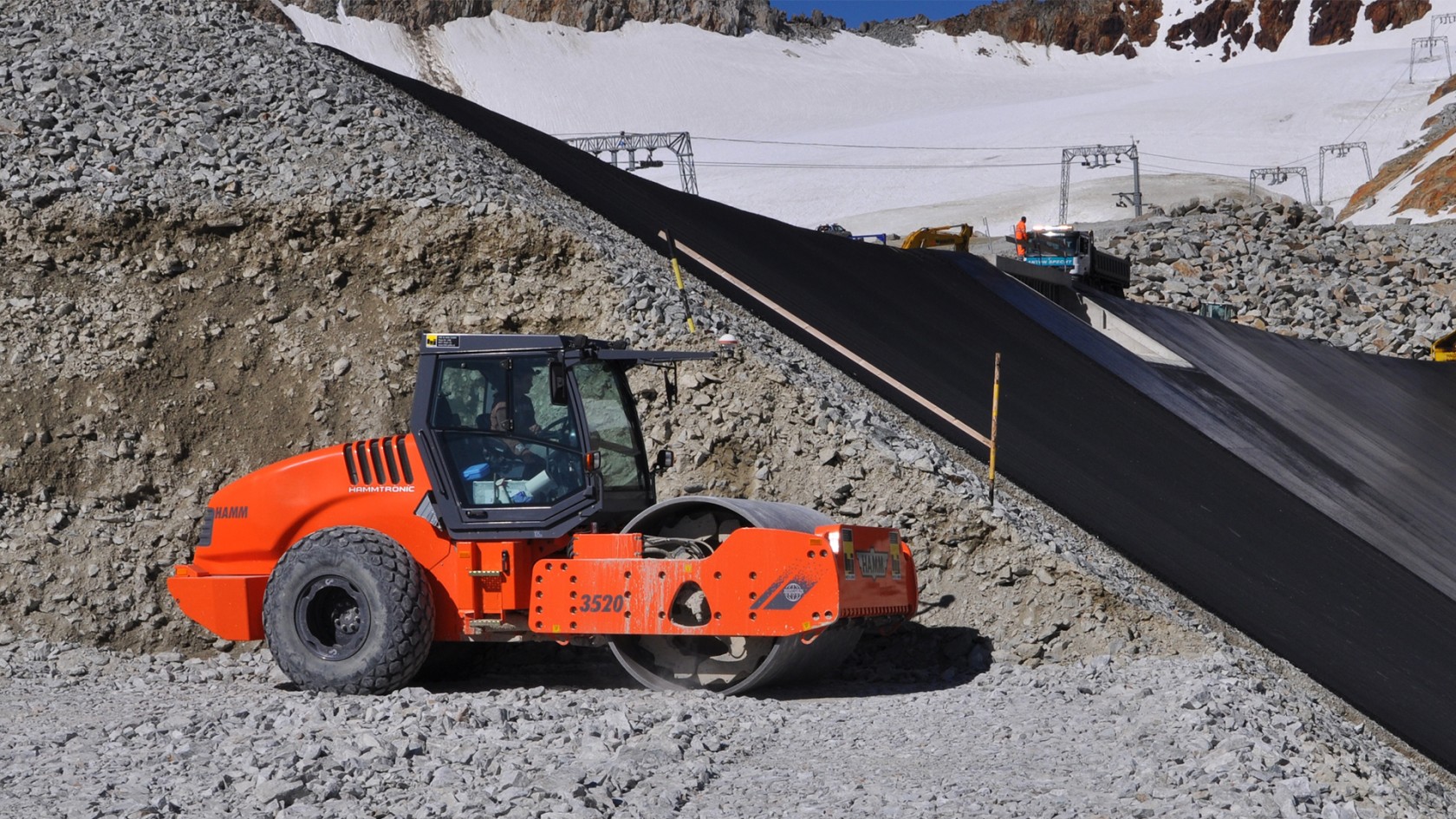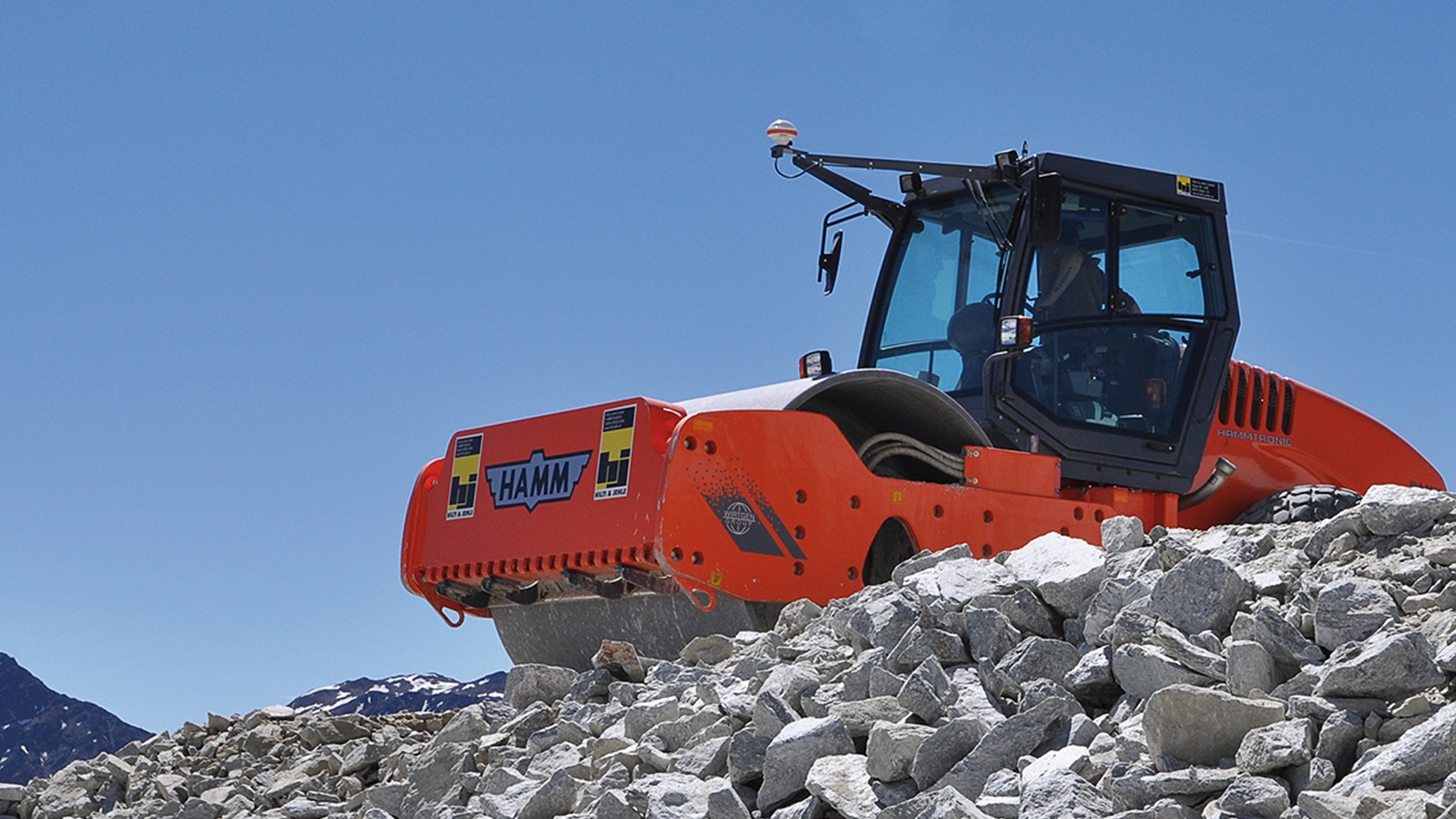

The largest artificial lake in Austria
Snow and ice dominate the landscape around the Tiefenbachferner glacier, which is located at an altitude of over 3000 meters in the Ötztal Alps nature preserve. Over the course of two summers, an artificial reservoir of immense proportions was constructed here. Starting in 2011, this reservoir will supply water for making artificial snow on the glaciers. Roughly 270,000 cubic meters of granite was blasted from the rock to form the basin for this lake, which is aptly named "Panorama". About 120,000 cubic meters of the granite was crushed and compacted with a HAMM 3520 HT compactor.
Glaciers are normally associated with "eternal ice", but global warming is threatening the glaciers in the Ötztal Alps: The Tiefenbachferner glacier has been melting continuously over the past 40 years; each year it lost one meter of thickness. In the aim of halting this process, the glacier will be covered with artificial snow in the future. The water will come from the new reservoir which will be used to create an important part of the artificial snow in the entire Sölden ski area. The artificial snow will provide a protective layer and snow reserve for the glacier, and most especially on its fragile edge. Skiers in Sölden will also benefit since artificial snow provides a perfect base for winter sport. The new artificial reservoir "Panorama" has impressive dimensions: With a volume of 405,000 m3, water depth of 17 meters and water surface area of 35,000 m2, it is the largest artificial lake in Austria. The water basin was created below the Tiefenbachferner glacier at an elevation of 2900 meters. A hollow in the mountain was prepared on one side and an artificial dam was built on the other side. HAMM technologies were used for this job. The work involved a series 3000 compactor equipped with Hammtronic and the "HCQ GPS navigator" measurement and documentation system. The machine was used to compact the crushed granite in layers to form the dam structure on the valley side of the lake.
A solid team: Kleemann crushers and HAMM rollers
On the opposite side, the basin for the artificial lake was created by blasting into the side of the mountain. Crushers were deployed to reduce the stone obtained in this process to a grain size of 0/200. The lion's share of the crushing work was handled using a mobile Kleemann MC 110 R crusher, set up right on the bottom of the new reservoir. Immediately after the stone was crushed, it was transported a few meters, using dumpers, to the opposite side where the HAMM compactor then created the new dam with up to 45 layers of a thickness of 50 cm each.
HCQ GPS navigator: Easy documentation of compaction
"HCQ" stands for "HAMM Compaction Quality" and comprises a wide array of different measurement and documentation tools. The GPS navigator was used in the Tyrol. This system basically consists of three modules: A receiver picks up signals from multiple GPS satellites and a differential satellite and determines the exact position of the roller independently of fixed reference stations. The second module – the compaction measurement system – is also very important. Using an acceleration sensor on the drum, the actual compaction is measured and transmitted to a rugged panel PC installed in the roller. This computer represents the heart of the system. It links the compaction measurement results with the position data at the time of the measurement and saves all of the relevant information. A "compaction map" is then displayed on the panel PC in the driver's cab. This map presents the measurement results to the operator using different colored markings, so the degree of compaction and number of completed passes are clearly visible.
Evaluation of the GPS navigator: Simple, fast and clear
Each time compaction of a layer was completed, engineer Hauser would read out the data using a USB stick and save it. The results are in the form of clear, unambiguous measured values and the interpretation process does not require any conversion or external software. "The HCQ GPS navigator delivers clear, traceable data that we can immediately interpret along with our customer. This simplifies the documentation process considerably," said the construction supervisor in praise of the system. In addition, operation on the actual roller is just as simple and convenient as the evaluation process. Using a user-friendly touchscreen, the operator or construction supervisor can enter the basic data. All the rest of the process is then handled automatically with no further operating steps required.
Hammtronic ensures dependability even under extreme environmental conditions
The compactor used to build the dam was equipped with the Hammtronic engine and machine management system. This ensures efficient usage of all of the machine's capabilities while monitoring the engine and vehicle functions, and especially the advance drive, vibration, oscillation and engine speed. The electronic engine management system ensures adaptation of the vibration system and driving speed to the current usage conditions. Of course, this contributes to ensuring a long lifespan for the machine itself. At an altitude of 2900 m, another benefit of Hammtronic became clear: Due to the lower air pressure, many of the construction machines suffered during sustained operation and could not deliver the necessary performance. On the other hand, Hammtronic responded to the environmental factors and adjusted the machine parameters accordingly. This ensured trouble-free operation even under these unusual operating conditions. Construction supervisor Ing. Alexander Hauser confirmed this: "During the construction period, some of the machines kept us busy with engine failures. But the equipment from the Wirtgen Group ran continuously despite the high altitude."
Dam construction completed after two years
After only two seasons of construction, the operators were able to begin filling the reservoir in mid-September 2010. Subtracting the delays due to sometimes capricious weather, a net construction time of just less than five months was obtained for the dam. During this time, the HAMM 3520 HT compactor processed about 120,000 m3 of granite. This enormous achievement made a sizable contribution to the fact that the reservoir could go into operation a whole season earlier than planned. Now, the people in Sölden only have to wait one year until the reservoir is completely filled so the water can be used for snowmaking.
